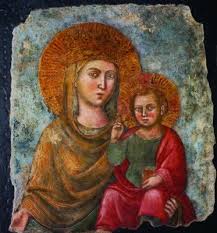Window-like, an icon is an encounter with the heavenly side. Here the Virgin Mary has stepped up to the window, holding her divine son. She is very beautiful and wears a crown, as she is Queen - Queen Mother. Her son is the Lord and so looks like a little man. He blesses us and holds a disc or orb that symbolizes the cosmic dimensions of his rule. What's the cosmic dimension? Perhaps it's the pictures of space captured by the Hubble telescope? Maybe it's the new world of now ever changing tele-communication? Maybe it's the realms of our complex minds and the even more complex realms of our hearts?
The initials MP ~ OY on either side of Mary stand for Theotokos - which means Mother of God, while the initials IC ~ XC on either side of her son stand for Jesus Christ. It's been said before, that Mary creates an atmosphere around Jesus. Here she has placed her son on a pillow and holds him securely. There are angels in the upper corners. Their wings seem to have flame in them.
Both The Mother of God and Jesus look at us squarely. There is no offering of profile that would break our communion with them. In some cultures it is a sign of disrespect to look someone in the eye, but not here. Here we are invited to look deeply and to allow ourselves to be looked upon deeply. Some people find it very difficult to maintain eye contact because they are not honest.
This icon encourages us to just look. We don't need to think religious thoughts. We don't need to fathom there are hidden messages to be heard or intuited. We don't need to do anything really. Just to sit and gaze.
Enhanced lips and whiter than white teeth seem to be all the rage these days. But in icons the mouths of Jesus, Mary and the saints are de-emphasized. That's because in heaven they are not needed for eating and so much talking. Our culture is obsessed with both. The icon invites us to a prolonged and deep silence, which is a wonderful way to pray.
Our Father, Who art in heaven...
There are options galore, and we all make our choices about how we will go, which path we will follow. Here is a way that will delight and ground us: Jesus is King! Mary is Queen!
Hail Mary, full of grace...
Some people say that to call Mary queen is outdated and irrelevant. Maybe. Then offer her the most over-the-top title you can come up with, as her response to God was over-the-top. Let the title express honor, gratitude and love.
Hail Mary, full of grace...
She is queen, but Queen-Mother - Mother of the King. She is the most sensitive one, the most wise and solicitous one. She is Queen-Mother: of the disenfranchised, the forgotten, the ignored, the weakest, the invisible ones.
Hail Mary, full of grace...
Regina Rosarium! Queen of the Rosary! The rosary is the chain that binds up Satan. In The Passion of the Christ, it is really Mary who is most hated by Satan. Why? Because she is the first to believe - to say yes to Jesus. The rosary is hers!
Hail Mary, full of grace...
Regina Mundi! Queen of the World! What a title! Our weary, wounded, anguished world of tears needs a mother's consolation, comfort and nurturing. And she tells the world, as she did at Cana. Do what he tells you.
Hail Mary, full of grace...
Regina Pacis! Queen of Peace! There are great queens in the world's history who made peace happen. And there are queens who urged their king-husbands or sons to make peace. War kills children. War is expensive. War steals from the poor. War is ruining our earth-paradise. We need heavenly help to make peace happen today.
Hail Mary, full of grace...
Regina Apostolorum! Queen of Apostles! The Creed says we believe in an apostolic faith. The word apostle means one who is sent out. Sent out for what? To share the good news of Christ's being with us, to change us, to grow-us-up, to make us new.
Hail Mary, full of grace...
Virgo praedicanda! Virgin most renowned! Her face has appeared on the cover of TIME magazine more than any other woman. Though slandered, attacked, mocked, ignored; Mary is here to stay. Love her!
Hail Mary, full of grace...
Queen of the Universe! Surely this title is too much. On the other hand, why not? We talk of space wars and a new telescope that will go back to the origins of light. Space is the new frontier. So why not, Mary, Queen of the Universe?
Hail Mary, full of grace...
Saint Bernadette said about the visions of Mary she experienced at Lourdes, It isn't my job to convince you of these things but only to tell you about them. Share with someone else that Mary and the Christ she holds in her arms are the source of your joy!
Hail Mary, full of grace...
Glory be to the Father...
 |
| Baby's Breath ~ Our Lady's Veil |




















.jpg)









